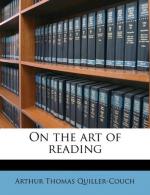That was the chirp of
Ariel
You heard, as overhead
it flew,
The farther going more
to dwell
And wing our green to
wed our blue;
But whether note of
joy, or knell,
Not his own Father-singer
knew;
Nor yet can any mortal
tell,
Save only how it shivers
through;
The breast of us a sounded
shell,
The blood of us a lighted
dew.
Well in music, in painting, this graduating which gives right proportion and, with proportion, a sense of distance, of atmosphere, is called Value. Let us, for a minute or two, assay this particular meaning of Value upon life and literature, and first upon life, or, rather upon one not negligible facet of life.
I suppose that if an ordinary man of my age were asked which has better helped him to bear the burs of life—religion or a sense of humour—he would, were he quite honest, be gravelled for an answer. Now the best part of a sense of humour, as you know without my telling you, consists in a sense of proportion; a habit, abiding and prompt at command, of seeing all human, affairs in their just perspective, so that its happy possessor at once perceives anything odd or distorted or overblown to be an excrescence, a protuberance, a swelling, literally a humour: and the function of Thalia, the Comic Spirit, as you may read in Meredith’s “Essay on Comedy,” is just to prick these humours. I will but refer you to Meredith’s “Essay,” and here cite you the words of an old schoolmaster:
It would seem to be characteristic of the same mind to appreciate the beauty of ideas in just proportion and harmonious relation to each other, and the absurdity of the same ideas when distorted or brought into incongruous juxtaposition. The exercise of this sense of humour ... compels the mind to form a picture to itself, accompanied by pleasurable emotion; and what is this but setting the imagination to work, though in topsy-turvy fashion? Nay, in such a case, imagination plays a double part, since it is only by instantaneous comparison with ideal fitness and proportion that it can grasp at full force the grotesqueness of their contraries[2].
Let us play with an example for one moment. A child sees such an excrescence, such an offence upon proportion, in an immoderately long nose. He is apt to call attention to it on the visage of a visitor: it intrigues him in Perrault’s ‘Prince Charming’ and many a fairy tale: it amuses him in Lear’s “Book of Nonsense”:
There was an old man
with a Nose,
Who said ’If you
choose to suppose
That my nose is too
long
You are certainly wrong’—
This old man he detects as lacking sense of proportion, sense of humour. Pass from the child to the working-man as we know him. A few weeks ago, a lady—featured, as to nose, on the side of excess—was addressing a North Country audience on the Economic Position of Women after the War. Said she, ’There won’t be men to go round.’ Said a voice ‘Eh, but they’ll have to, Miss!’ Pass from this rudimentary criticism to high talent employed on the same subject, and you get “Cyrano de Bergerac.” Pass to genius, to Milton, and you find the elephant amusing Adam and Eve in Paradise, and doing his best:




